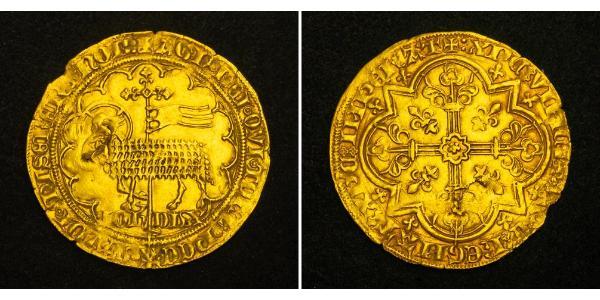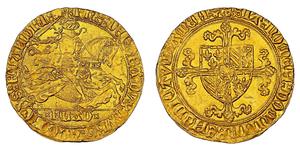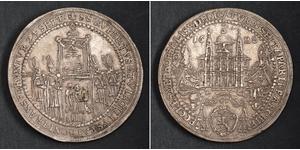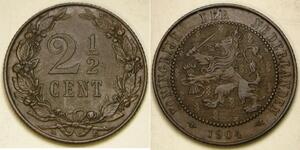(sold for $1481.0)
1383 Brabant, Jeanne & Wenceslas of Luxembourg. Scarce Gold Mouton d'or Coin. R!
Mint Place: Vilvorde
Mint Period: 1355-1383
Denomination: Mouton d'or (Gold Sheep)
Reference: Friedberg 8 ($1200 in VF!), Delmonte 43, de Mey 388, Witte 387. RR!
Condition: Damaged (planchet split on sheep`s face), lightly ragged rim, otherwise about XF!
Diameter: 30mm
Weight: 4.53gm
Material: Gold!
Obverse: Pascal lamb (it`s sheep-like look brought this type`s name = Mouton d'Or = Gold Sheep) before cruciform staff with flying banner within circle of arches.
Legend: + AGN'°DEI°QVI°TOLL'°PECAT'°MV'DI°MISE°NOB:
Reverse: Ornate cross with lis in quarters framed by 4 arcs and 4 angles with small lis in angles.
Legend: + : XPC++VINCIT++XPC++REGNAT++XPC++IMPERAT
The Duchy of Brabant was a State of the Holy Roman Empire established in 1183. It developed from the Landgraviate of Brabant and formed the heart of the historic Low Countries, part of the Burgundian Netherlands from 1430 and of the Habsburg Netherlands from 1482, until it was dismembered after the Dutch revolt. Present-day North Brabant (Staats-Brabant) was adjudicated to the Generality Lands of the Dutch Republic according to the 1648 Peace of Westphalia, while the reduced duchy remained in existence with the Southern Netherlands until it was conquered by French Revolutionary forces in 1794.
Authenticity Unconditionally guaranteed.
Joanna, Duchess of Brabant (24 June 1322 – 1 November 1406), also known as Jeanne, was the heiress of Duke John III, who died in Brussels, December 5, 1355. Her mother was Marie d'Évreux.
Joanna's first marriage, in 1334, was to William IV, Count of Holland (1307–1345), who subsequently died in battle and their only son William died young, thus foiling that project of unifying their territories.
Her second marriage was to Wenceslaus of Luxemburg. The famous document, the foundation of the rule of law in Brabant called the Blijde Inkomst ("Joyous Entry"), was arrived at in January 1356, in order to assure Joanna and her consort peacable entry into their capital and to settle the inheritance of the Duchy of Brabant on her "natural heirs", who were Joanna's sisters, they being more acceptable to the burghers of Brabant than rule by the House of Luxembourg.
The document was seen as a dead letter, followed by a military incursion in 1356 into Brabant by Louis II of Flanders, who had married Margaret, Joanna's younger sister, and considered himself Duke of Brabant by right of his wife. With the Duchy overrun by Louis' forces, Joanna and Wencelaus signed the humiliating Treaty of Ath, which ceded Malines and Antwerp to Louis. By August 1356 Joanna and Wencelaus had called upon the Emperor, Charles IV to support them by force of arms. Charles met at Maastricht with the parties concerned, including representatives of the towns, and all agreed to nullify certain terms of the Blijde Inkomst, to satisfy the Luxembourg dynasty.The duchy continued to deteriorate with Wencelaus' defeat and captured at the battle of Baesweiler in 1371.
On Joanna's death, by agreement the Duchy passed to her great-nephew Antoine, the second son of her niece Margaret III, Countess of Flanders.
Her tomb was not erected in the Carmelite church in Brussels until the late 1450s; it was paid for in 1459 by her sister's grandson, Philip the Good. Though it was destroyed in the course of the French Revolutionary Wars, its appearance has been reconstructed from drawings and descriptions by Lorne Campbell, who concluded that the tomb was an afterthought, providing an inexpensive piece of propaganda for Philip's dynastic rights.
Wenceslaus I (also Wenceslas, Venceslas, Wenzel, or Václav, often called Wenceslaus of Bohemia in chronicles) (Prague, 25 February 1337 – Luxembourg, 7 December 1383) was the first Duke of Luxembourg from 1355. He was the son of John the Blind, King of Bohemia, and Beatrice of Bourbon.
In 1353 Charles IV King of Bohemia, Count of Luxembourg and elected Holy Roman King, entrusted the county, their father's inheritance, to his half-brother Wenceslaus. In 1355 when Charles was crowned Holy Roman Emperor he raised Luxembourg to the status of a duchy. In 1352, Wenceslaus married Joanna (1322 – 1406), daughter of John III, Duke of Brabant and Limburg, and Marie d'Évreux. In 1355, Joanna inherited Brabant and Limburg. In order to guarantee the indivisibility of Brabant, Wenceslaus signed the Joyous Entry, but had to fight against his brother-in-law Louis II of Flanders, who asserted his share of the duchy. He failed to prevent the seizure of Brussels by the Flemings, but a certain Everard 't Serclaes succeeded by an audacious coup in driving them out of the city. Thereafter, Wenceslaus had to face primarily internal disorders. In 1371, he overestimated his military capacities and waged war with William II, Duke of Jülich, resulting in the humiliating defeat of Baesweiler, losing a part of his army, and several noblemen. He was captured and suffered 11 months of captivity.
He died in Luxembourg and was succeeded by Antoine de Valois as duke of Brabant and by Wenceslaus II as duke of Luxembourg. There are speculations that he might have died of leprosy (Joanna stayed in Brussels). His last wish was his heart to be displaced from his dead body and sent to his wife. He is buried in a crypt at the ruins of Abbaye d'Orval in Belgium.
Wenceslaus I of Luxembourg wrote troubadour poetry which was found by Auguste Longnon in Jean Froissart's Méliador in 1890s (Wenceslas was a maecenas of this chronicler). It comprises 79 poems (11 ballades, 16 virelais, 52 rondeaux).
Only 1$ shipping for each additional item purcheased!

|
Posted by:
anonymous 2014-03-17 |
9 coin descriptions were improved from 2025-05-28 to 2025-06-04
One of them is:
1 Gulden Kingdom of the Netherlands (181 ...
group has 5 coins / 5 prices
22 coins were grouped from 2025-06-11 to 2025-06-18
One of them is:
2 1/2 Cent Netherlands
group has 18 coins / 14 prices
⇑















-300-150-nRgsHgTyozIAAAGW7ltyjN9I.jpg)







